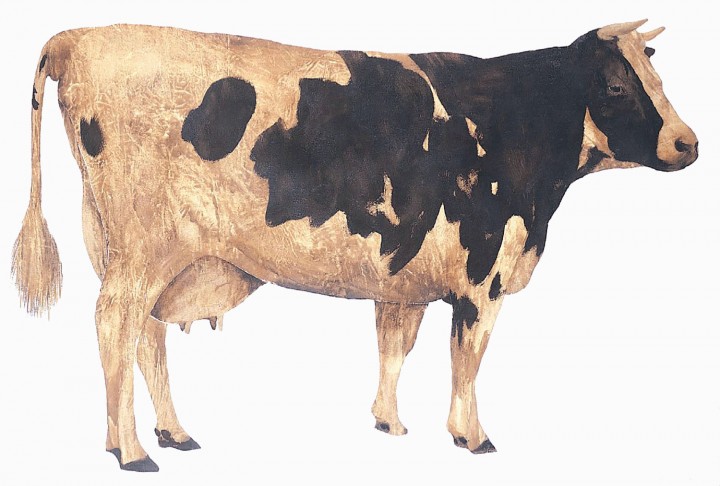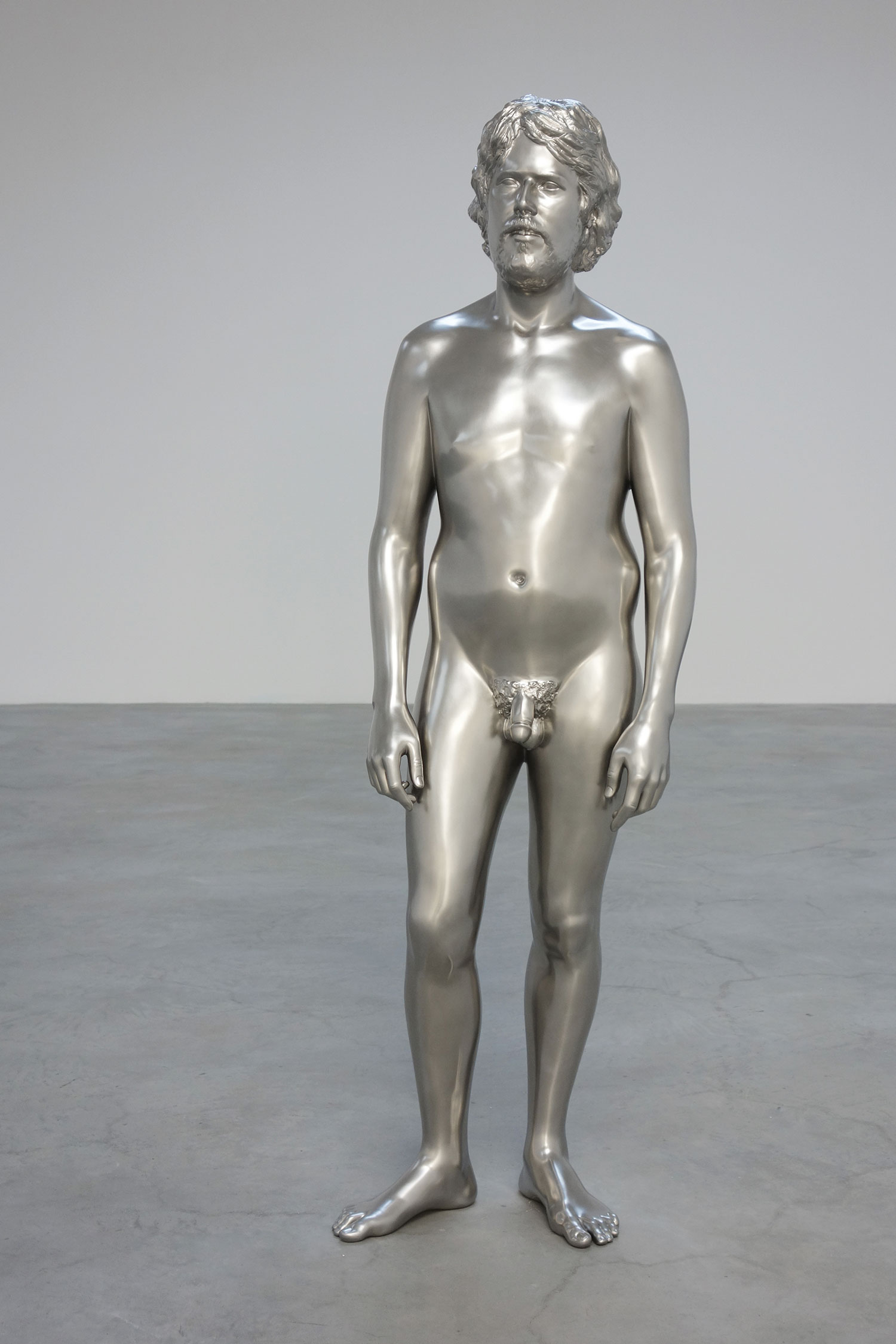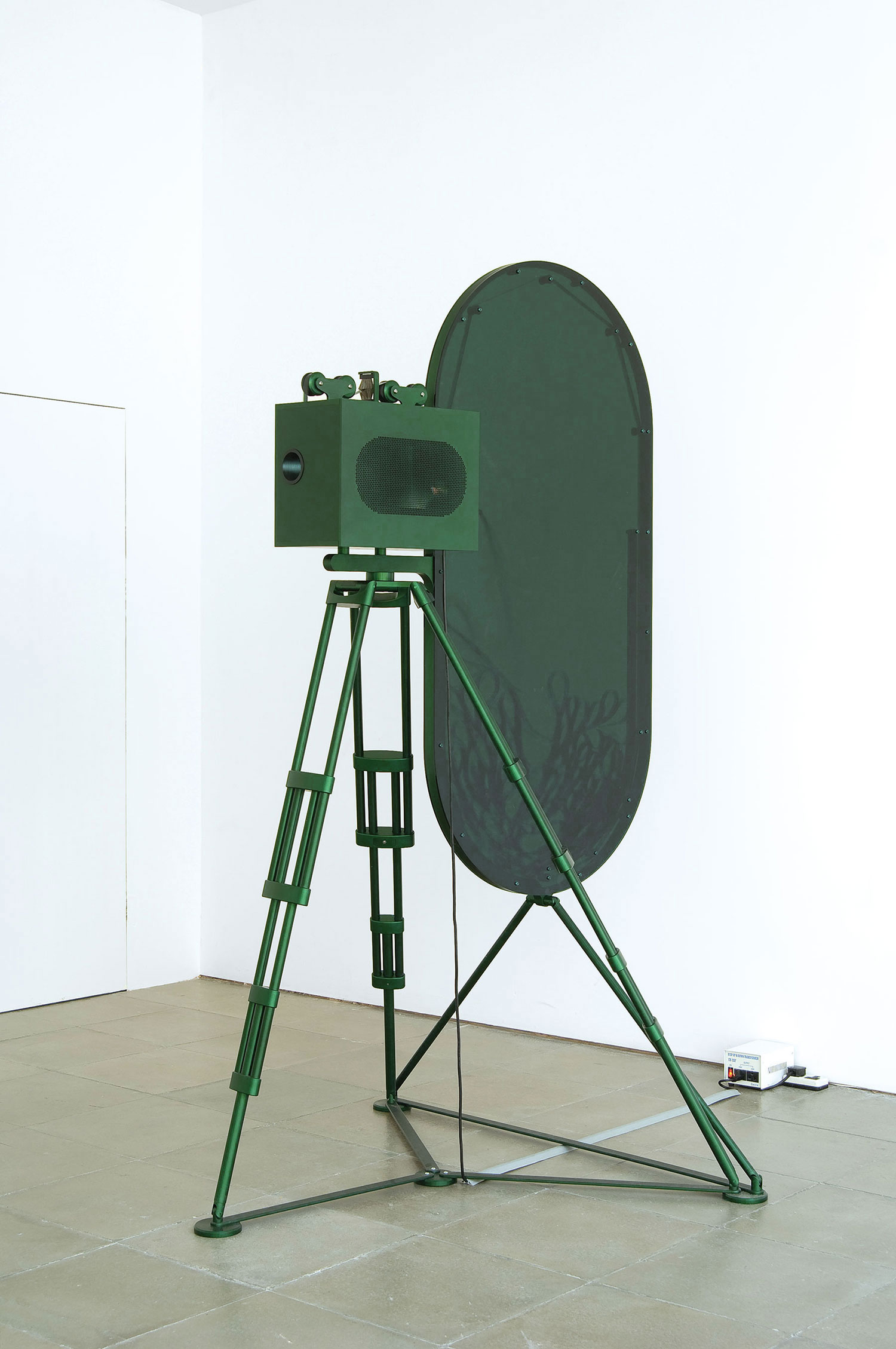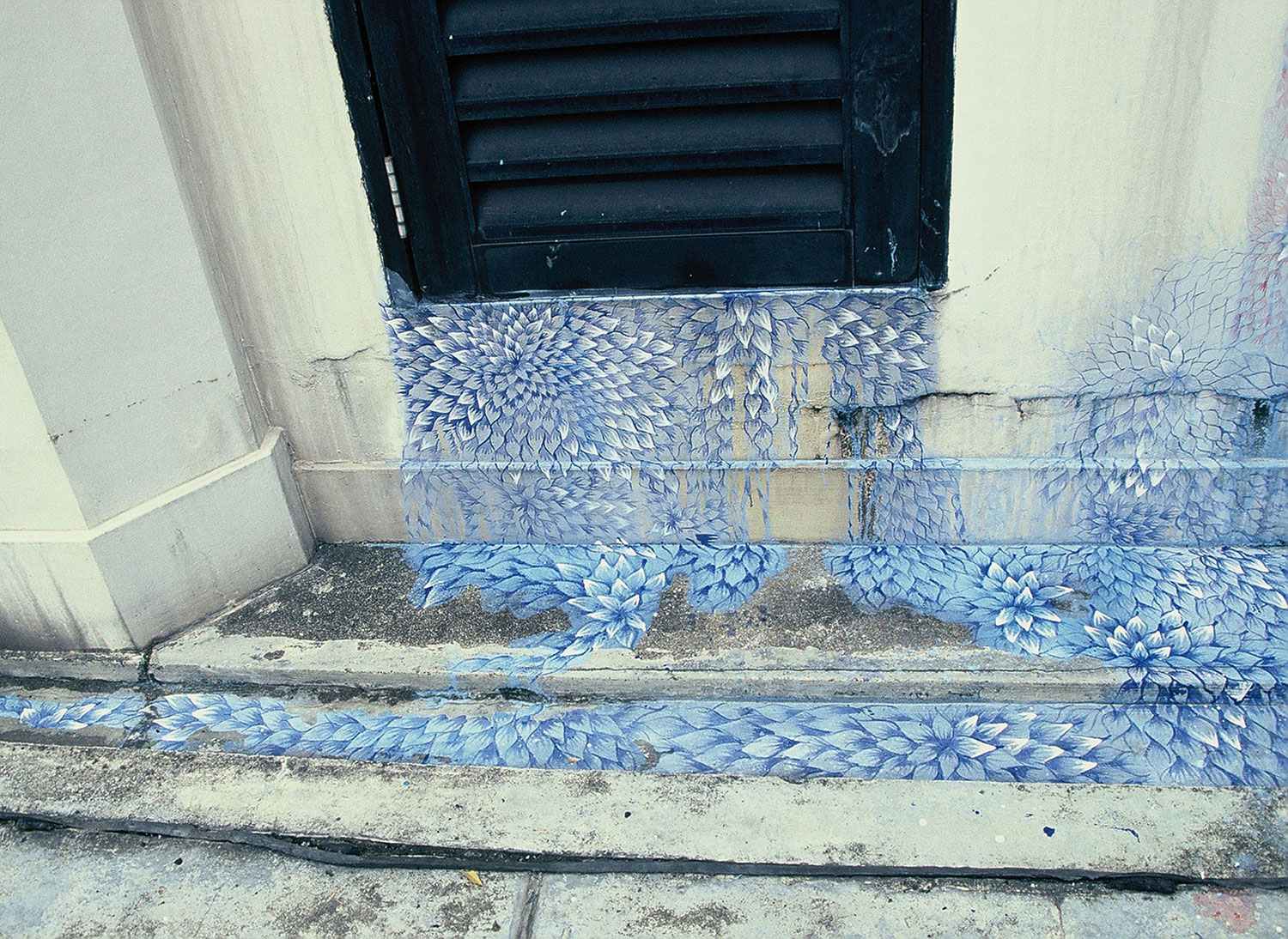
Maurizio Cattelan: This might not be the best way to start, but I have to ask you, what’s with all the bloody heads and obscured faces?
Llyn Foulkes: I’ve been doing those since the ’60s. A face is the most important part of a portrait, and when I obliterate that, I’m creating a blank slate, a painting.
MC: Did you know you wanted to be an artist?
LF: Ever since I was a kid. At the age of 19 I was drafted into the Army, the Korean War, sent to Germany for two years. I traveled all over. It opened my eyes to everything. I saw the Flemish painters and went all the way down to North Africa and Italy. Barcelona knocked me out. I saw the Sagrada Familia Church and it just blew my mind. That made me really want to be an artist. I saw all the great paintings all over Europe, at a very early age. I went back in ’65, six years after art school, because I had won the Paris Biennale. I bought a VW van in Germany because it was half the price to ship it back then. So my family camped in the van for three months all over Europe, which was really great.
MC: You went to school at the Chouinard Art Institute, right?That’s now CalArts?
LF: I only went to art school for two years.
MC: Who did you study with there?
LF: The professors that influenced me the most were Donald Graham, Richards Ruben and Emerson Woelffer. Graham taught all the Disney animators how to draw. He started me off on a project: do your own thing, or illustrate whatever you want. It could be a story, a poem. So I took something by Edgar Allan Poe. Richards Ruben is somebody who’s been left out of the art history of Los Angeles. He had two shows at Ferus. I only had one show at Ferus. He influenced my painting, as did Emerson Woelffer. Oh, and the other one that influenced me was Jules Langsner. He was a brilliant critic and was teaching art history. He turned me on to Picasso. I still have the paper I wrote on Picasso. He gave me an A+.
MC: Who are some of the other students who were in art school at the time you were there?
LF: Let’s see: Larry Bell, Joe Goode, Ed Ruscha, Jerry McMillan, Ron Miyashiro, Bob Mackie. But my closer friends were Ed Bereal and Stephan von Huene. Then after I’d been there a year and a half, I won first prize for drawing and painting at the school, and then I left and went to Ferus because Richards Ruben told me to take my stuff over there. Irving Blum was really the one that saw my work first; he recognized, or discovered me.

MC: Disney took over CalArts soon after you left Chouinard, no? Tell me about your thing with Disney and Mickey Mouse. What did they do to you? I saw a painting of yours with Mickey Mouse lying dead on the floor and you’re standing there with a smoking gun [Deliverance, (2007)].
LF: I read the first page from [a letter Disney wrote regarding] the Mickey Mouse Club from 1934:
The Mickey Mouse Club is an organization for boys and girls suggested by the Mickey Mouse cartoons… The primary purpose of the club is twofold. It provides an easily arranged and inexpensive method of getting and holding the patronage of youngsters. Through inspirational, patriotic character-building phases, it aids children in learning good citizenship, which in turns fosters goodwill among parents. Everyone knows how strong the gang instinct is in kids. The Mickey Mouse Club is unique in that it furnishes entertainment of the most popular nature and at the same time implants beneficial principles. The latter is so completely shorn of any suggestion of lessons or lecturing that children absorb them almost unconsciously.
This was the real beginning of marketing on a grand scale, and it worked. I had a show in 1996 at [Patricia] Faure called “The Legend of Mickey Rat,” and the critic David Pagel accused me of McCarthyism for going after Disney. I wrote a letter back to the Los Angeles Times talking about how I was concerned about children and what was happening to them. I included the first page of the Mickey Mouse Club letter. The Times printed my letter but they deleted the part about implanting things in children’s minds. That only showed me Disney makes their newspapers go with all their advertising. And it made me start to realize we don’t always get the real news, not if it has to do with anything that’s anti-commercial. So when I looked at that letter, I thought: if that had been in Mao’s Red Book, about implanting things in children’s minds and patriotic blah blah blah, you would have thought, “Oh yeah, those communists.” There it is right there. Nobody goes after Disney. I feel like I’m a lone person out there going against it all the time. He’s so American. To not like Mickey Mouse would be un-American. That’s why I had the song:
Once upon a time there was a mouse
He lived in every house
People did not set traps for him
because it was a sin
His job was to keep everyone clean
To run people through his washing machine
He had a white face
He kept the right pace with his patriotic jive
MC: How did you get that letter?
LF: I got that from my former father-in-law, Ward Kimball, who was one of the Nine Old Men at Disney Studio. Walt was like a father to Ward, so he didn’t even think anything about it. I just read it and all of a sudden I thought, “What?” I just saw the beginning of marketing right there, and that just suddenly started to ring a bell in my head.
MC: Have you ever had any problems with Disney, like a cease and desist?
LF: No. When I had my 1995 survey that started in the Laguna Art Museum, right in the middle of Orange County, The Orange County Register — I guess there’s a lot of Democrats trying to go against the establishment there — put this picture of mine on the cover of their calendar section, in color, with Mickey coming out of my head, and it said “Danger.” In the show, I had that letter in a piece, as I did in the Hammer show [Made in Hollywood, (1983)]. They never did a thing because if they made a fuss about it, people would become aware of the document. So, it’s better for them to say it’s just art; it will go away if you just ignore it. But I’m determined to keep on going.
MC: So you wrote that song about Mickey Mouse. I’ve heard that you are a serious musician and have a Machine that you play. Tell me about The Machine.
LF: I played drums in a rock band from ’65 to ’71. Then I got fed up with it, because the music had gotten so loud.
MC: But back to The Machine…
LF: After that in ’73 I started The Rubber Band. I started going back to my childhood, collecting horns. I’d go to all of the swap meets. In The Rubber Band, I had a washboard with horns on it. I had a snare, a bass drum and a few cowbells. That was it. There were seven musicians in the band. We were on “The Tonight Show” in ’74. Then after the band I just decided I would try to make it a one-man band, so I acquired more horns and arranged them to play in standard chords. Then I started getting all these weird chords because I tried to get as many together as I could. I didn’t hook the bass up till about 1987. It used to be just the bass drum, but as I soon as I hooked the bass up, it changed everything. I play the bass with my foot and I’ve gotten very good at it. It took me a long time. When you’re doing everything else you really have to listen to it.
MC: Sounds very complicated.
LF: When I played the drums you had all these accessories you had to put in cases or fold up. So I decided to make it mostly all one thing.

MC: Is The Machine a way for you to take a break from painting and working in the studio?
LF: Yes, it is. And I mostly write all my own songs.
MC: Is it portable?
LF: Well, the main part is on wheels. When I perform, afterwards some people stay, and then I invite them to come up and see how I do it. They’re always surprised. When Documenta 13 wanted to ship the whole thing over there, I was a little leery about that, because I’ve never had anybody pack my machine up and ship it. It comes apart in five sections.
MC: I’ve mostly seen your little paintings recently, but a couple of them were dimensional and had like a three-dimensional self-portrait in a landscape. Have you always done this assemblage work?
LF: I’ve never considered myself an assemblage artist. Most assemblage artists take things and assemble them. I’ve always considered myself a painter from the very beginning. I always thought in terms of painting. My idol in art school was de Kooning, so when I started working on painting, or if you want to say assemblage, or putting things on it, it was different. I was involved in the painting space. The art world never knew where to put me, which in the long run was probably a good thing. I started getting in the art magazines because of the painting, not because of the other work I had done before that, which had assemblage in it. I could whip the paintings out faster because they were on canvas and weren’t as much of a struggle. Other artists that are my contemporaries order the canvases and the stretcher bars. I never did that. It used to be, when I walked in my studio — early on, like the mixed-media work I exhibited at the Pasadena Art Museum in 1962 — I would touch something and it would be magic. It would just happen. By 1966 the magic had disappeared, and I knew it. I was just sort of copying myself, in a sense. Then David Stuart said, “You got to have a show.” He says, “You’re on top of it. You won the Paris Biennale.” I took three months off from UCLA — where I was teaching — and made seven six-by-nine-foot, two ten-by-twelve-foot and five five-by-five-foot canvases. Made the stretcher bars myself. Stretched the canvas myself. I started doing things that I’d never done before like using an overhead projector, like Lichtenstein did, and blowing up the rock images. Five major museums bought those paintings right away, because I was on top, but when I look at those paintings now, it’s a whole different feeling. They just fill up the big museums, but if you get too close to them, it’s not as interesting. It’s not like my early work when I was using the rag, and every part meant something. I stopped doing those big paintings and I started doing the bloody heads. I started having things come off the canvas or frames. Then it started a whole thing, which led me up to what I’ve been doing lately. I have been getting back into actually creating a space in a painting with material difference. When I look at a painting like The Lost Frontier (1997-2005), I say, “Nobody’s done a painting that deep.” It’s because I went back to my roots. Just like in the music.
MC: I’ve seen pictures of The Lost Frontier. It’s like a diorama, no? Would you call that your masterpiece?
LF: The Lost Frontier took seven years in the making. I think the process is really important. A lot of people really miss the process now. Some teachers now say, “Well, just come up with a good idea.” Well, shit, man, come on. After a while you leave out the whole process. And it’s gotten to the point now where you don’t even need to make it. Well, come on now.
MC: Oops, you must hate my work. Good thing I’ve retired. Would you ever retire?
LF: Hey, the art world kind of turned its back on me for quite a while. I had to climb back up again. They wanted me to do that same thing over and over again. Then all of the collectors can have them, and they can all say, “Oh, I have a such and such, see?”
MC: Sometimes it’s better if they all hate you and leave you alone.
LF: Sometimes you feel like you just want to disappear and go out into the country. It’s funny.





